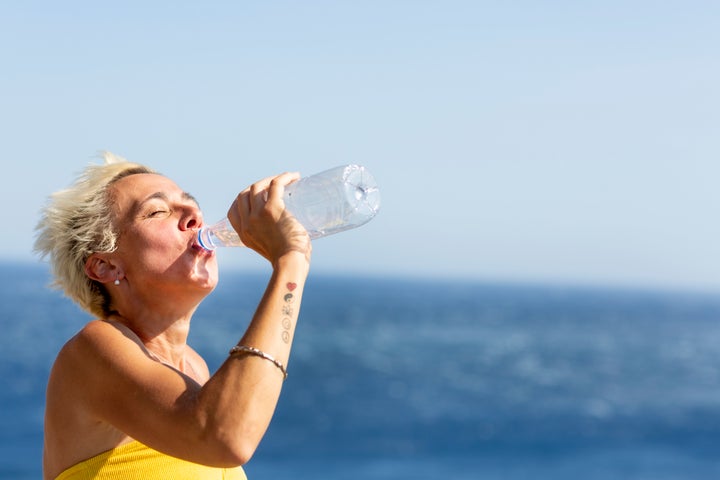
This story was originally published in 2022.
Hot weather, especially a record heatwave like the one hitting UK and most of Europe at the moment, comes with a host of problems – and dehydration is a very common one.
If you’ve been struggling to keep your house and yourself cool the past few days, you’ve probably also noticed you’re feeling a lot thirstier than usual.
As we all know, warm weather makes us sweat more, leaving us at risk of dehydrating as that water leaves our body. That means we need to drink up.
While we’re encouraged to drink at least a litre of water on an average day, how much should we be consuming when it’s really hot out?
How much water should you drink on a hot day?
The NHS recommends drinking 1.2 litres of water per day (six to eight glasses), but some experts advise a much higher amount, suggesting we drink up to 3 litres – spaced throughout the day.
Bhaskar Somani, a consultant urological surgeon at University Hospital Southampton NHS Foundation Trust, told the Yorkshire Evening Post the UK needs a “radical culture change towards the consumption of water” if the country is to stay hydrated during a heatwave.
As with anything, too much of a thing can be dangerous, including water. You shouldn’t drink more than a litre of water within an hour, advises Medical News.
Drinking too much in a short space of time can lead to water intoxication – or overhydration – when the normal balance of electrolytes in your body exceeds safe limits. This disturbs your brain functions and in rare cases can be fatal.
So how do you drink the right amount of water for you? Firstly, identify when you’re needing to drink more.
What are the the symptoms of dehydration?
Signs you are dehydrated can include:
Headache
Feeling thirsty
Dark yellow and strong smelling urine
Feeling dizzy or lightheaded
Tiredness
Dry mouth, lips and eyes
Sweating less than usual
Urinating fewer than four times a day.
How can you lower your risk of dehydration?
The NHS says you can reduce the risk of dehydration by:
Drinking fluids when you feel any dehydration symptoms
If you find it hard to drink because you feel sick or have been sick, start with small sips and then gradually drink more
Using a spoon to make it easier for your child to swallow the fluids
Drinking enough during the day so your pee is a pale clear colour
Drinking when there’s a higher risk of dehydrating. For example, if you’re vomiting, sweating or you have diarrhoea
For children, as well as giving them water, try hydrating foods and drinks that they’ll also enjoy, including ice cream, yoghurts, lollies, and soups.
Three easy hacks for staying hydrated
Invest in a good water bottle
There’s no shortage of snazzy water bottles about. You could pick a smart one that tracks how much water you’ve consumed or simply one that looks pretty and nice to hold. Sometimes the right kit does help.
Embrace the power of electrolytes
There’s a reason sports people love them – the same reason your mum used to give you Lucozade after you’d had a stomach bug. Dehydration can cause electrolyte imbalance in your body – when the concentration of essential minerals your brain needs to function is out of whack with the amount of water in your body. Sip an electrolyte drink or try a rehydrating sachet or tablet like Phizz (which contains electrolytes and multivitamins) to get back to a balance.
Drink small sips, not big gulps
How can you consume more liquid in the day without needing to go to the loo every five minutes and losing it? Well, the secret might be in how you drink it.
According to the experts, you should take small sips throughout the day rather than chugging it down in one go. So now you know, drink up.